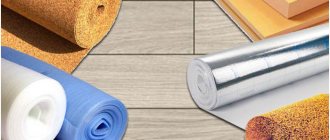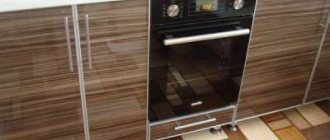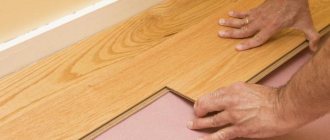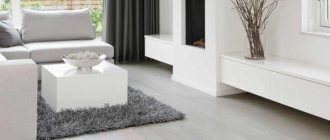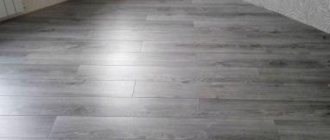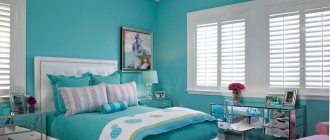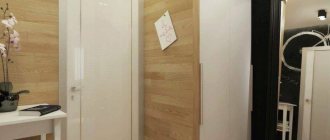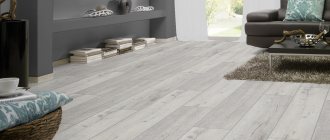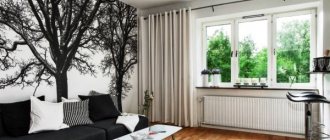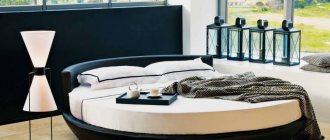Kinds
The name linoleum imitating laminate implies a type of linoleum that visually imitates a laminate coating. The classification of linoleum coverings, including those imitating laminate, is based on the material, design features and intended purpose.
Classification according to materials of manufacture:
- Natural;
- PVC;
- Rubber;
- Nitrocellulose.
Classification by level of durability and wear:
- Domestic. These are coverings ~4 mm thick, made of synthetic PVC on a foam and fabric base. This linoleum is soft and has good heat and sound insulation properties.
This covering option is used in children's rooms, bedrooms and offices; it is practical and inexpensive, quite aesthetic and is used “under laminate”.
- Semi-commercial. Unlike the first, household type, the semi-commercial one has a thicker layer of protection, durability and a higher wear resistance class (31-32). As a rule, it is used for flooring in hallways, corridors, living rooms, kitchens, as well as business premises with limited traffic. It reliably recreates laminated panels, looks respectable and includes many of the qualities of household and commercial linoleum.
- Commercial. Made from polyvinyl chloride. Often this is a single-layer type of 33-34 wear resistance class, used without additional backing. Often used for flooring in shopping malls and areas with high traffic, educational institutions and large office premises. It has a thick protective layer (0.5 mm) and wear resistance class 33-34, is durable, can last up to 25 years, and shows a high level of resistance to fracture, friction, and vertical pressure. In its production, many special additives are used that increase quality indicators and positive characteristics. Such linoleum, as a rule, has a high cost.
Classification by structure:
- Homogeneous or single-layer, made from a mixture of polyvinyl chloride and dyes, has the highest quality characteristics in terms of wear resistance;
- Heterogeneous or multilayer, including five layers or more. The first is a base made of fabric or foamed PVC. The second one adds fiberglass to increase strength. The third layer plays a decorative role and also has a protective coating. Heterogeneous linoleum can be of both household and semi-commercial types.
Homogeneous options are usually sold in a limited assortment and in a single color variation (mainly light or dark tones). Although, there are also original new items.
Heterogeneous coatings have a wider range of colors and better imitate laminate, wood or tile coatings, which is why they are more popular on the market.
Linoleum can also be divided into two types based on the presence of a base. To lay coverings with a base made of polyvinyl chloride, jute or felt, no additional substrate is required.
Thanks to the modern production system, linoleum can be laid either in individual strips or in shaped fragments, depending on the type of room.
Laminate installation - features
Preparatory work before laying linoleum.
The durability of the coating directly depends not only on its quality, but also on the quality of installation. Therefore, if you do not have sufficient experience in laying parquet and do not know how to lay laminate flooring, then it is better to contact qualified specialists. In any case, the following conditions must be met:
- do not lay the laminate brought from the store immediately for several hours or one day, leave it in the package for a couple of days: the material must acquire the required humidity and temperature corresponding to the environment;
- When installing, pay attention to the consistency of the pattern and texture; in some cases, the direction of the panel is indicated by arrows;
- Before laying laminate flooring on linoleum, prepare tools and materials in advance (knife, hammer, tape measure, marker) so that during the work you do not have to take trips to the store;
- pay attention that the relin on which the laminate will be laid is firmly adhered to the base using special glue and does not have swelling or tears;
- if the main coating is on a thick soft base, then it is better to dismantle it, despite its apparent complexity, otherwise the new laminated coating will sag during operation and will require another replacement;
- a substrate for the laminate is necessary in any case, regardless of the type of surface; it can be made of cork or polyethylene foam;
- Start laying the laminate from the window along the walls, this will allow you to visually veil the seams between the panels;
- leave a gap of 1 - 1.5 cm around the perimeter of the room so that the floor can “play” freely when it shrinks or swells;
- laying is carried out exclusively on a dry, prepared surface.
Related article: What else besides wallpaper can you decorate your bedroom walls with?
Material
- Natural coatings are made from lime, cork meal, resin and linseed oil, while having a jute or felt base. They are environmentally friendly and non-flammable, so they are perfect for bedrooms and children's rooms.
- PVC is made from polyvinyl chloride and a thin protective layer. Such coatings, as a rule, do not have a base, have a short-lived characteristic odor, are toxic at elevated temperatures, and are also subject to shrinkage.
- Relin - fits in technical and production rooms. As a rule, it consists of two layers (the upper one is often rubber). Relin has moisture resistance properties, but its main disadvantage is toxic fumes.
- Nitrocellulose or colloxylin. These are single-layer versions of linoleum without a base. They have great elasticity, moisture resistance and strength, which is why they are often used in spaces for sports. Disadvantages include easy flammability and toxicity at elevated temperatures.
The products are characterized by a five-layer (including the base) structure, with the addition of lime powder, quartz sand and talc.
Distinctive characteristics
Linoleum coverings have a number of competitive advantages over laminate.
Including:
- Moisture resistance;
- Lightness of coverage;
- High quality thermal insulation;
- Quiet while walking;
- Tolerance to damage;
- Structural integrity;
- High degree of durability.
It is necessary to install linoleum coverings in rooms where there are no open sources of fire and away from direct sunlight.
Advantages and disadvantages
The main advantages of linoleum coating include
- Durability and wear resistance (in the case of commercial and semi-commercial types);
- Excellent look and wide palette of shades;
- Easy to install, easy to lay;
- Excellent heat retention;
- fire safety;
- Moisture resistance.
In addition to the advantages, it is necessary to indicate the disadvantages:
- Many products contain harmful components (unlike more environmentally friendly laminate);
- Quality options can be expensive;
- Cheap options, at first, may have a pungent odor, which, however, dissipates over time;
- During repairs, as a rule, the entire canvas is replaced.
Pros and cons: comparison with laminate
In this comparison, linoleum differs in its advantages and disadvantages.
| pros | Minuses |
| Linoleum is much easier to lay. | Some types may contain harmful substances. |
| Laying roll material takes less time. | There may be an odor. |
| More resistant to moisture. | Less environmentally friendly, unlike laminate. |
| It is an affordable budget option. | In case of surface damage, only complete replacement of the blade is possible. |
| When loaded with heavy objects, dents appear. | |
| No joints. | Fade over time when exposed to ultraviolet light. |
Each of the materials has its own unique characteristics, advantages and disadvantages and can be used under certain conditions. Before choosing, first of all, take into account the intensity and nature of the load on the floor surface, as well as your own taste preferences.
The photo shows linoleum with imitation laminate boards in the interior of a small living room.
Design
The design solution in the production of linoleum for laminate plays a huge role in the production of roll-type products. Expensive series are characterized by an original choice of surface pattern. Various lines and curves, artistic abrasions and chamfers, an abundance of visual effects that can implement the most daring and creative solutions in the design of a room, for example, adding volume, simulating old wood flooring or an endless board.
Tones are selected depending on the lighting level. For example, light coatings are recommended for dark rooms. For English, classic or antique styles, the color of a whitewashed board is suitable. The noble colors of wenge and stained oak overload the space, so contrast with light walls and furniture can be applied to them.
The optimal choice of color is determined by the correct selection of the element, which is the central color point, the contrast with which will determine the overall picture of the space. Such an element could be a door, carpet or furniture. For example, linoleum with relief embossing or a pattern of radial wood cutting is suitable for lacquered furniture, and a pattern for tangential cutting is perfect for creating a wooden interior.
The color of the type of wood that linoleum imitates determines the aesthetics of the entire floor covering of the room.
If you want to give the room a stately look, corresponding to a business space, the optimal color would be imitation ash, oak, mahogany or beech. Also, this ensemble will look great in the fireplace rooms of country residences. At the same time, imitation cherry or teak will harmoniously fit into the design of a retro room.
Linoleum colors
The most popular color scheme.
Grey
A neutral color that allows you to shift attention to interior elements, while creating an excellent background for them.
White
Creates additional space and lightness in the room, while always being luxurious. Decorating the room with white linoleum will give it an elegant look.
Black
An optimal and elegant option that perfectly complements the stylish interior and laconically emphasizes the original furnishings of the entire space.
Beige
Light and sophisticated beige color will create a special, sophisticated ambience in the room, complement the atmosphere with warmth and comfort and will be an excellent solution for a variety of design projects.
Brown
A wide palette from light walnut to dark chocolate can take on different shades depending on the lighting of the room and play with colors in the tone of the light flux. Brown color will fit perfectly into a room or living room.
Wenge
A strict, noble and aristocratic color has always added sophistication to any room, and was also considered a sign of high cost.
Blue
The variety of shades of blue will give the room a touch of freshness, calm and peaceful silence, visually expanding and “refreshing” the space.
Recommendations for choosing coverage
The pattern and shade of the floor must be chosen taking into account not only the decor, but also the purpose of the room. Gray linoleum in the living room interior should be purchased in wide rolls. Otherwise, an abundance of seams can ruin the overall aesthetics.
To decorate the bedroom, you should use material with a fabric backing.
And the bathroom and kitchen should be lined only with PVC products. This linoleum is moisture resistant, which will ensure longer service life.
Children's rooms should be decorated only with natural material made using jute.
Other tips:
- For the shadow side, it is worth choosing light shades. A cold palette is suitable for rooms with a southern orientation.
- If the width of the room is small, you need to choose a floor with a pattern. It should go diagonally to the long walls or across them.
- Gray linoleum in the interior can create the illusion of a large space if it is made to look like small tiles.
Photo of linoleum in the interior of rooms
Let's look at the most popular options for using linoleum.
For kitchen
Linoleum kitchen flooring always fits harmoniously into almost any design project, becoming a stylish and original interior detail, complementing its atmosphere and creating original visual effects. Warm-toned flooring gives the dining space a calm and soft homey feel, while cool-toned linoleum laid diagonally will add space to even the smallest kitchen.
For the hallway and corridor
Semi-commercial roll covering 3 mm thick in a dark and discreet color is perfect for the hallway and corridor. Since these rooms are often cleaned, this option will, firstly, be less susceptible to scratches and damage, and secondly, it will hide invisible marks and stains.
For the living room
Household linoleum, imitating a laminate made of noble wood, is perfect for the living room, where it will create an atmosphere of high cost and nobility. And for rooms with heavy and massive furniture, you can use thicker and more durable linoleum coverings.
For children's room
An excellent choice for a children's room would be a household or semi-commercial natural covering, which has a high degree of strength, environmental friendliness and high heat-retaining properties. A high-quality protective layer and resistance to damage will allow the coating to serve for many years, decorating the children's room.
For the bedroom
If you want to give your bedroom a cozy and intimate atmosphere, as well as achieve a good level of sound insulation, then linoleum flooring will be the optimal solution for you. Warm shades will create the desired visual effect, and noise absorption is one of the most important competitive advantages of high-quality linoleum.
Look at the photo of linoleum similar to laminate to find what you need.
And if you are still thinking about what is more practical: laminate or linoleum, watch the video below: https://www.youtube.com/watch?v=HQbvHxTCsno&feature=emb_logo
Stages of laying linoleum on laminate
- Additionally, level the floor surface with sheets of fiberboard or chipboard, nail them or fasten them with self-tapping screws.
- Rub the seams between sheets of material.
- If you don’t have time to buy fiberboard or chipboard, you can level the existing parquet using a plane and coarse sandpaper. The recesses are filled with plaster or acrylic putty.
- When the putty has dried, you can begin further installation work.
- Linoleum is laid, the seams are cold welded or secured with small nails and decorative strips. Hot welding is contraindicated for fire safety reasons.
This method is not always acceptable. It is appropriate only if the quality of the laminated materials is preserved. If there are traces of fungus or mold between the panels and the floor, the laminate still needs to be removed and the surface treated with special impregnating compounds.
Now you know how to lay linoleum, and you can carry out the installation work yourself without additional financial costs.
Article on the topic: Bathtub: economical do-it-yourself renovation, photo instructions


